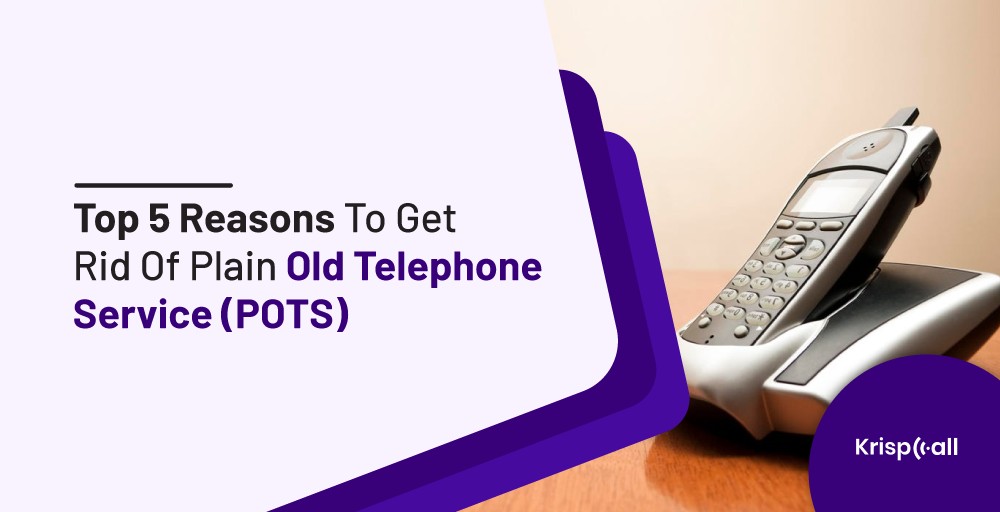Landline phones used to be the kings of communication in the past. As with all kings, to conquer the world, a new king comes and replaces the old king.
The new king now, is the 📱 VoIP phone system, ruling the communication world through its powerful and more dominant features.
But fortunately, landline phones are not completely replaced as of now. It still has its place in the communication world, in places where VoIP doesn’t reach.
Plain Old Telephone Service, also known as Public Switched Telephone Network ☎️, uses landlines for handling phone calls that require copper wire connection.
In this article, we will learn more in detail about how POTS has become a thing of the past and why you should consider a better solution like VoIP.
What is Plain Old Telephone Service (POTS)?
Plain Old Telephone Service (POTS) is a kind of phone service that uses analog telecommunication technology. POTS is also referred to as PSTN (Public Switched Telephone Network). Public telecommunication requires Infrastructure and services that are provided through the PSTN.
The PSTN is a collection of a circuit-switched network of telephones managed by national, regional, and local telephony companies around the world.
The full form of POTS is Plain Old Telephone Service and it was first introduced in 1876 at the World’s Fair. It was the beginning of a new area for communication systems.
Communication takes place between two parties via a pair of twisted copper wires. These copper cables are the transmission medium used for sending analog voice signals.
The caller’s sound waves or voice messages are changed into electrical signals and passed through the network to the receiver.
Telephone lines, cellular networks, microwave transmission links, communications satellites, fiber optic cables, and under-the-sea telephone cables are all interlinked via switching centers allowing many phones to communicate with one another.
PSTN, Plain old phone services, fixed-line phones, or simply landlines are all terms used for phones. PSTN phones are still widely utilized and regarded as a common mode of communication.
The PSTN, which began as a network of fixed-line analog telephone systems, is now almost totally digital in its network infrastructure which incorporates mobile and other networks in addition to fixed lines.
👋 Read More About: Web phone: How to maximize business communications with Internet Telephony
How does Plain Old Telephone Service System Work?
The many aspects of the POTS network collaborate to carry out a series of processes in order to make a phone call.
However, the traditional telephone service creates a dedicated circuit between two points for the period of transmission.
Businesses are linked to central offices in the area through a simple telephone service. Long-distance offices or residents are connected to the central office.
The call is routed through one or more switching offices that operate locally, nationally, or worldwide to make connections and allow the parties to interact over the POTS line.
The old traditional telephone call, conducted over PSTN, used circuit-switching as a technique of communication.
This is what typical traditional Old Plain Telephone Services work like.
- The PSTN networks are linked by central offices that serve as phone exchanges, each serving a specific geographic area.
- When person A calls person B, the telephone network tries various circuits to discover an access channel. Before they can begin talking, they must first establish a link.
- Once a channel has been selected, it ensures full bandwidth and stays connected for the rest of the communication session unless users disconnect.
- You are basically renting the lines when you make a PSTN call. This is why making an international or long-distance phone call was so costly.
However, just like digital data packets, you can now obtain phone service distributed over the internet using VoIP technology.
The largest circuit-switched network is the plain old telephone system (POTS).
Pros of using POTS Line are:
- Works even when power is cut off or Internet connection.
- It is a more secure and dependable channel of communication.
- Easy-to-use infrastructure
- Cost Less than VoIP
Cons of using POTS Line are:
- Even if the two devices are not sharing data, the connection path will stay active which will be wasting memory.
- It takes longer than packet-switching to make a connection between two hosts before data can be exchanged.
- Limited Features
- Maintenance is High
👏 Also, read about Telephone Network Vs Internet: Similarities and Differences
What are the reasons to get rid of Plain Old Telephone Service lines?
When the internet service is down and you can’t connect with others online, you can make calls using your home telephone, which is known as POTS Telephone Line or PSTN. In a way, it’s reassuring. However, when you factor in the cost of a landline, it’s a costly option.
So, in addition to the cost, there are other elements that make landline phones a bad option which we’ll go over one by one below.
1. Cost
In contrast to a PBX phone system, the price of installing a landline system as well as the cost of an extra line is extremely high.
Plain Old Telephone Service (POTS Line) charges a lot for international calls. A call using the Cloud Phone System is significantly less expensive than on analog systems. Additional capabilities like intercom, call transfer, and directories are more expensive.
Infrastructure setup depends on the size of the company. The larger the company, the higher the setup costs including the technician and maintenance charges.
2. Maintenance
Landline telephone systems rely heavily on their wire systems, therefore keeping them in good working order is critical. If your home’s cables are damaged, the price of the repair will mount.
3. Inclement weather conditions
Inclement weather such as freezing temperatures, tornadoes, hurricanes, heavy rain, high winds, and other natural disasters can damage and impair landlines in a matter of seconds.
4. No Flexibility
Landline phones were the ideal way for offices to communicate with clients and employees who were located far away. However, you’ll have to take all of your business calls from your workplace. The landline phones are inflexible because they are fixed on your work desk with a copper wire connection.
5. Fewer features and services
As much as Plain Old Telephone Service (POTS Telephone Line) intends to provide the best features and services, they are still no match to the services of VoIP phone systems. On top of that, getting them is costly as well as time-consuming. There may be a need to get additional hardware to add a feature.
POTS VS VoIP: Which is right for you?
Plain Old Telephone Service (POTS) phone line may appear to be the more expensive alternative compared to VoIP. However, It is more reliable in locations where cellular or internet service is poor or non-existent. A POTS landline phone system will come to your rescue if everything else fails.
In today’s world, however, most enterprises are migrating from POTS to VoIP phone systems to enhance their business communications.
Voice over IP (VoIP) allows you to send voice and data via the internet from one side to another. It allows you to link remote offices and maintain a consistent level of communication.
KrispCall is a powerful VoIP phone system that will make you forget about POTS. It provides features like IVR, calls forwarding, call routing, softphones, etc. for a better calling experience.
Furthermore, VoIP systems lower or eliminate international calling rates because charges are based on a monthly subscription rather than distance and time.
Try Schedule Free KrispCall demo now, to experience the difference between POTS and VoIP. For more information, subscribe to the KrispCall newsletter.





